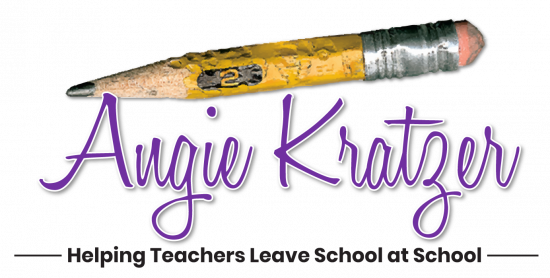
It was an experiment. My third year teaching, I gave up working at home for Lent. I had no second job and no husband or kids to come home to, so I just stayed late and got it done. I would throw open my windows so that I could hear the marching band practice, and I would grade essays, plan, and get ready for the next day. No line at the copier. Easy peasy.
Then there was a husband and a child and a second job and a commute and 150 students, half of whom were in my AP English Language & Composition classes. I came up with a few strategies, stole a few, experimented some more, and developed a list of “try this” ideas for English teachers who would really like to leave work at work yet still be effective.
Before reading the list, stop and write down your top five priorities (the ideal, of course, not the real, which would look something like Work, Nutella, Friends, Netflix, Myself). For me, the ideal would be God, Stan (husband), Samuel (son), Health, Writing.
1. Stop deceiving yourself.
As a girl growing up in the midst of the Women’s Lib Movement of the early 70s, I was taught that I could have it all–at the same time. It was a lie. Maybe it’s just my temperament, but I could not manage being the best teacher, the best wife, the best mom, the best employee, the best friend, the best daughter, a prolific writer, and a person who sits on the back porch and drinks coffee.
Something must give. Either your marriage will weaken, you will parent passively, your other relationships will suffer, your own health will suffer, or you will let go of being Teacher of the Year. Take your pick. For 20 years, I chose my students over all else. 100 pounds later, I was a really good teacher with hypertension and breast cancer.
2. Know your numbers.
An administrator once told me that a teacher should spend three hours planning for every one hour of instruction. I taught four different courses for six hours a day, so that would mean twelve hours of planning for just one school day. In a week, that’s 60 hours. On top of planning, there’s grading. With 150 students, if I spent only ten minutes on each essay, it would take me 25 hours each week to grade papers. We’re at a 75-hour week, and I haven’t even facilitated instruction yet. I was actually in my classroom with other human beings for about 30 hours a week, so that puts me at 115 hours. Let’s add the commute, faculty meeting, parent conferences, department meeting, PLC meetings, and school events, and I’ll round off to 120 hours. A week. That’s three full-time jobs. Just do ONE of them.
3. Don’t reinvent the wheel.
If TeachersPayTeachers had been around when I started, I might have shaved off a couple of panic attacks those first few years. Go there now. Leave my blog and go look at the thousands and thousands and thousands of free syllabi, lesson plans, tests, and units. There are curriculum specialists, Ph.D.s, veteran teachers, and fresh minds who write lessons that incorporate Twitter, Snapchat, Facebook, Instagram, QR codes, and texting. Materials are aligned with Common Core State Standards, TEKS, SOLs, you name it.
Now let’s get practical. What does it look like to leave work at work?

4. Work efficiently at school.
Think of tasks in five-minute increments. If you have a small window of time, use it to pull materials for copying, read a few paragraphs, or call one parent. Those increments add up! At times, I taped a “No students before 8:30” note to my doorknob. Most days, I ate in my room at lunch and worked. I hid in the bathroom when administrators were roaming the halls looking for people to cover classes. I turned out my light and graded essays in the corner of my room on workdays so that others thought I wasn’t there.
What!? That’s my social time! I need the fellowship! Go back and look at that priority list you wrote down a few minutes ago. Get your chat on, and then go hide in the bathroom.
5. Think in paragraphs.
Essay grading is the real time killer, right? We can’t grade those in spurts; if I put an essay down, I have to read the whole thing over when I pick it up again. I love the paragraph approach. Have students write and turn in one paragraph at a time, especially when they are learning literary or rhetorical analysis. Hand that one paragraph back and ask for revision. Conferences are short, grading is quick, and you end up with stronger writers. Grab a stack of paragraphs on the way out to lunch duty, stick them on a clipboard, and use that “five minutes” strategy. I always did thesis first, then body paragraphs, then the introduction, then the conclusion. By the time students put the whole thing together, you’re grading for transitions and mechanics, not content.
6. Choose weekdays OR weekends.
It’s impractical to think that an English teacher can get away with never taking work home, but you need to give your brain and spirit a sabbath. I’m a fan of weekend work. By the time I got home during the week, I was spent, cranky, and a lot more likely to be overly critical of a student’s work. Oddly, I used to love staying late on Fridays. Teachers were driving over students trying to get out of the parking lot, and the building was quiet. I cleaned my boards, did my copying, and prioritized what I could get done over the weekend. When possible, I got my grading done on Saturday so that I had Sunday for family.
7. Grade holistically.
It’s a rare child who will look at all your comments, take them to heart, revise a graded essay, and refer back to the comments while writing the next essay. Did you just sigh? I did too. Deal with one major issue when grading and find one significant strength for comment (no, really, there’s one in there). Better yet, use a checklist or matrix rubric. Big picture evaluation is better for you and the student.

